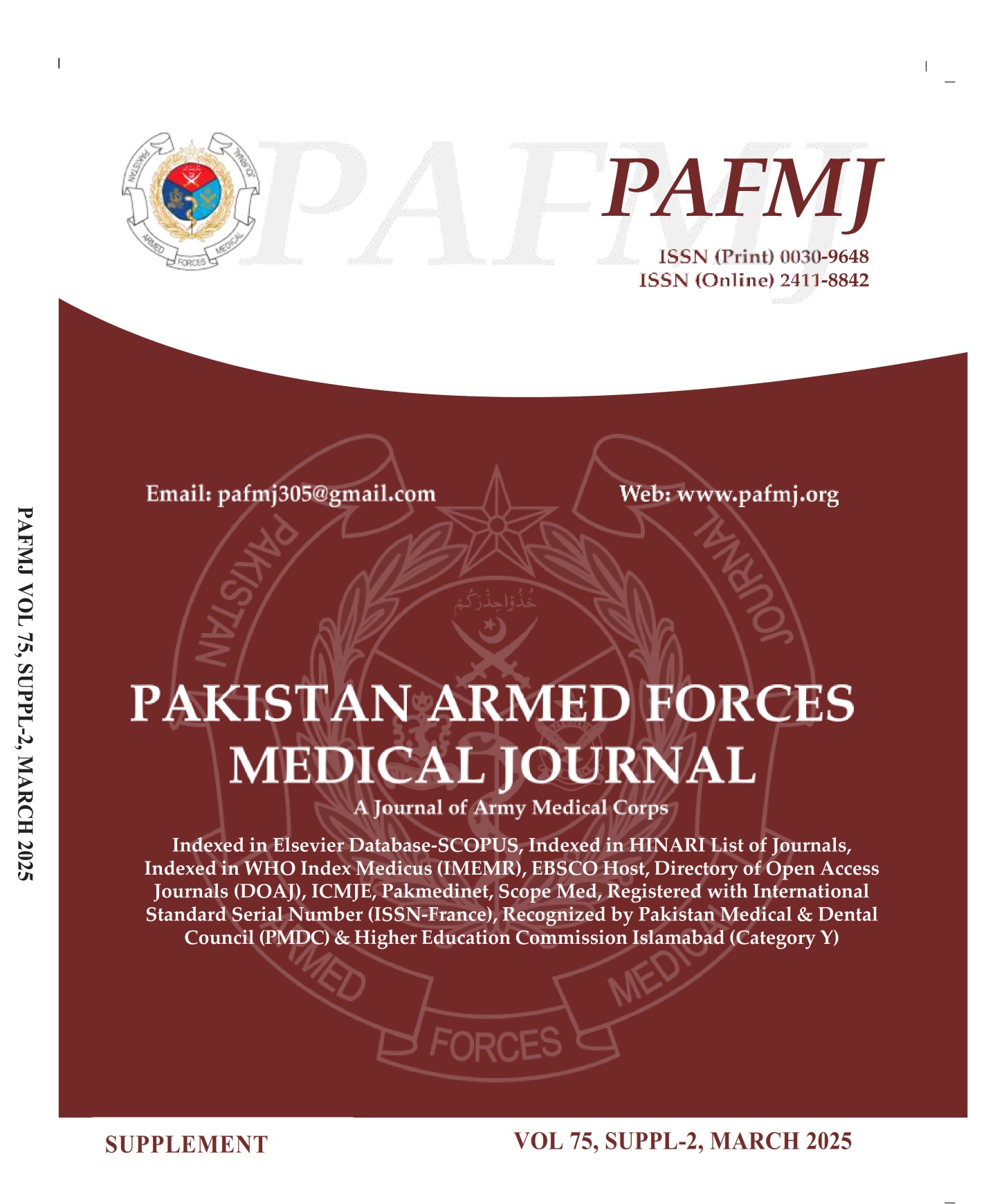Incidence of Bile Duct Injury after Laparoscopic Cholecystectomy at Combined Military Hospital Rawalpindi
DOI:
https://doi.org/10.51253/pafmj.v75iSUPPL-2.9725Keywords:
Bile Duct Injury, Cholelithiasis, Laparoscopic Cholecystectomy.Abstract
Objective: To determine the incidence and risk factors of bile duct injury after laparoscopic cholecystectomy.
Study Design: Prospective cross-sectional study.
Place and Duration of Study: Combined Military hospital, Rawalpindi Pakistan, from Jan to Nov 2022.
Methodology: All patients with age 18 to 70 years of either gender undergoing laparoscopic cholecystectomy were followed for 30 days. Common bile duct injuries were defined based on the Strasberg-Bismuth classification. Injuries following laparoscopic cholecystectomy are categorized using the McMahon categorization system as either major or minor, depending on their severity.
Results: Of 962 patients, the incidence of bile duct injury was observed in 8(0.8%) patients. A statistically significant association of incidence of bile duct injury was observed with cholecystitis (p-value 0.029), renal disease (p-value 0.038), and obesity (p-value 0.026). Of 8 patients with bile duct injury, obesity was found in all, i.e., 8(100%). Most of the bile duct injuries were diagnosed postoperatively, i.e., 6(75.0%) whereas 2(25.0%) were diagnosed intraoperatively. Half of the patients with CBD injury had Type A Strasberg-Bismuth injury, i.e., 4(50.0%), 2(25.0%) had type D, whereas 1(12.5%) had type E1 and type E5 each. While McMahon classification report that 5(62.5%) had a minor depth of injury whereas 3(3.4%) had a major depth of injury.
Conclusion: Incidence of laparoscopic cholecystectomy was observed in less than 1% of the patients. Patients with cholecystitis, renal disease, and obesity are at-risk. Type A Strasberg-Bismuth injury was found in majority of the patients.
Downloads
References
Kim SS, Donahue TR. Laparoscopic Cholecystectomy. JAMA 2018; 319(17): 1834. https://doi.org/10.1001/jama.2018.3438
Basunbul LI, Alhazmi LSS, Almughamisi SA, Aljuaid NM, Rizk H, Moshref R. Recent Technical Developments in the Field of Laparoscopic Surgery: A Literature Review. Cureus 2022; 14(2): e22246. https://doi.org/10.7759/cureus.22246
van de Graaf FW, Zaïmi I, Stassen LPS, Lange JF. Safe laparoscopic cholecystectomy: A systematic review of bile duct injury prevention. Int J Surg 2018; 60: 164-172.
https://doi.org/10.1016/j.ijsu.2018.11.006
Strasberg SM. A three-step conceptual roadmap for avoiding bile duct injury in laparoscopic cholecystectomy: an invited perspective review. J Hepatobiliary Pancreat Sci 2019; 26(4): 123-127. https://doi.org/10.1002/jhbp.616
Khan JS, Ahmad R. Common Bile Duct Injury in Laparoscopic Cholecystectomy: A Comparative Audit. Ann Pak Inst Med Sci. 2015; 11(4): 164-167.
Mangieri CW, Hendren BP, Strode MA, Bandera BC, Faler BJ. Bile duct injuries (BDI) in the advanced laparoscopic cholecystectomy era. Surg Endosc 2019; 33(3): 724-730.
https://doi.org/10.1007/s00464-018-6333-7
Memon W, Khanzada TW, Samad A, Laghari MH. Complications of laparoscopic cholecystectomy at Isra University hospital, Hyderabad. Pak J Med Sci 2009; 25(1): 69-73.
Strasberg SM, Hertl M, Soper NJ. An analysis of the problem of biliary injury during laparoscopic cholecystectomy. J Am Coll Surg 1995; 180(1): 101-125.
McMahon AJ, Fullarton G, Baxter JN, O'Dwyer PJ. Bile duct injury and bile leakage in laparoscopic cholecystectomy. Br J Surg 1995; 82(3): 307-313.
Viste A, Horn A, Øvrebø K, Christensen B, Angelsen JH, Hoem D. Bile duct injuries following laparoscopic cholecystectomy. Scand J Surg 2015; 104(4): 233-237.
https://doi.org/10.1177/1457496915570088
El-Dhuwaib Y, Slavin J, Corless DJ, Begaj I, Durkin D, Deakin M. Bile duct reconstruction following laparoscopic cholecystectomy in England. Surg Endosc 2016; 30(8): 3516-3525.
https://doi.org/10.1007/s00464-015-4641-8
Martin D, Uldry E, Demartines N, Halkic N. Bile duct injuries after laparoscopic cholecystectomy: 11-year experience in a tertiary center. Biosci Trends 2016; 10(3): 197-201.
https://doi.org/10.5582/bst.2016.01065
Reinsoo A, Kirsimägi Ü, Kibuspuu L, Košeleva K, Lepner U, Talving P. Bile duct injuries during laparoscopic cholecystectomies: an 11-year population-based study. Eur J Trauma Emerg Surg 2022.
https://doi.org/10.1007/s00068-022-02190-9
Yang S, Hu S, Gu X, Zhang X. Analysis of risk factors for bile duct injury in laparoscopic cholecystectomy in China: A systematic review and meta-analysis. Medicine (Baltimore) 2022; 101(37): e30365.
https://doi.org/10.1097/MD.0000000000030365
Terho P, Sallinen V, Lampela H, Harju J, Koskenvuo L, Mentula P. The critical view of safety and bile duct injuries in laparoscopic cholecystectomy: a photo evaluation study on 1532 patients. HPB (Oxford) 2021; 23(12): 1824-1829.
https://doi.org/10.1016/j.hpb.2021.04.017
Yuda Handaya A, Werdana VAP, Fauzi AR, Andrew J, Hanif AS, Tjendra KR, et al. Gallbladder adhesion degree as predictor of conversion surgery, common bile duct injury and resurgery in laparoscopic cholecystectomy: A cross-sectional study. Ann Med Surg (Lond) 2021; 68: 102631.
https://doi.org/10.1016/j.amsu.2021.102631
Terho P, Sallinen V, Lampela H, Harju J, Koskenvuo L, Mentula P. The Critical View of Safety in Laparoscopic Cholecystectomy: User Trends Among Residents and Consultants. Surg Laparosc Endosc Percutan Tech 2022; 32(4): 453-461.
https://doi.org/10.1097/SLE.0000000000001077
Gonzalez-Urquijo M, Hinojosa-Gonzalez DE, Rodarte-Shade M, Gil-Galindo G, Flores-Villalba E, Rojas-Mendez J. Use of the self-reported critical view of safety in laparoscopic cholecystectomy during residency. Surg Endosc 2022; 36(5): 3110-3115.
https://doi.org/10.1007/s00464-021-08612-w
Díaz-Martínez J, Chapa-Azuela O, Roldan-García JA, Flores-Rangel GA. Bile duct injuries after cholecystectomy, analysis of constant risk. Ann Hepatobiliary Pancreat Surg 2020; 24(2): 150-155. https://doi.org/10.14701/ahbps.2020.24.2.150
Downloads
Published
Issue
Section
License
Copyright (c) 2025 Saqib Ali Awais, Arslan Sharif Malik, Iftkhar Ahmad, Javed Iqbal Niazi, Jehangir Ali Soomro, Hassan Mehmood

This work is licensed under a Creative Commons Attribution-NonCommercial 4.0 International License.















